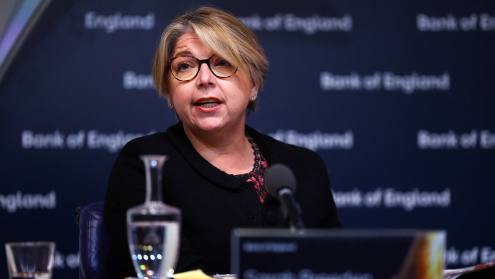For every central bank in the world that issues its own currency, monetary policy is an overarching priority. Georgia is no different. We have come a long way since the introduction of the Georgian lari in 1995, and while there still is room for improvement, I can without exaggeration say that our monetary policy overall has been quite successful.
Its success rests on the inflation targeting framework — in place since 2009 — with the traditional prescriptions of monetary independence and exchange rate flexibility as cornerstones. Despite a long and bumpy road of almost 15 years, replete with severe economic shocks, the market’s medium-run inflation expectations are well anchored.
Pre-emptive policies are key to greater resilience and lower policy trade-offs at times of risk-off episodes. In this regard, we could say that we are a part of that select club of emerging market economies (and even some of the smaller advanced economies, too) that deploy a mix of policy tools against the headwinds in the presence of balance sheet mismatches, dominant currency pricing in trade and a shallow foreign exchange (FX) market, all of which impair the re-equilibrating mechanism of a flexible exchange rate.
However, down the road, formalising the policy actions is vital to ensure policy transparency and deliver results in a more efficient way. We are grateful to the International Monetary Fund for the enormous amount of work done on conceptualising the application of the policy mix through the Integrated Policy Framework (IPF).
The IPF is still a work in progress and we are eager to discover more of its benefits allowing us to adopt the framework in a formal way. In particular, modelling work should provide us with the necessary instruments to calibrate the mix and analyse the transmission mechanism of a combined application of policy tools. Although it is hard to reach a firm consensus on an economic theory, recent research reveals that exchange rate flexibility still maintains traction in absorbing external shocks except, for example, for the presence of a shallow FX market, where FX interventions might help.
However, to make the policy feasible one needs deep pockets in terms of FX reserves. And the National Bank of Georgia (NBG) is truly committed to building them up whenever market conditions allow. At the onset of the Russia-Ukraine war we expected a sharp tightening of external conditions, but our region surprisingly experienced a surge in capital inflows. Meanwhile, accumulation of reserves in this situation is further justified because the inflows could turn out to be just temporary and revert.
Furthermore, to avoid the “contractionary depreciation” due to balance sheet mismatches, macroprudential measures could also be deployed pre-emptively to build up buffers and increase resilience to shocks. While all of this is theoretical, we need more empirical tests as to whether these measures work in practice.
Dollarisation and measures against it
We see the IPF as a new frontier to update our policy toolkits. At the same time, we need to remain focused on addressing structural weaknesses, too. In fact, the very first line of defence against shocks is to maintain sound macroeconomic policies and enhance long-term reforms to de-dollarise balance sheets, develop capital markets to tilt borrowing in favour of local currency, which would be key to reduce monetary policy trade-offs in the long run.
The recent economic turbulence once again highlighted the importance of de-dollarisation. Indeed, macroeconomic and price stability coupled with consistent market reforms have gradually reduced dollarisation over the years, with the bulk of the improvement coming in the past decade. However, it still remains way above its estimated natural level of 30%. International experience clearly shows that, once dollarisation takes hold, it is hard for economic agents to switch back to local currency. With that in mind, in 2016 the NBG, together with the government of Georgia, implemented de-dollarisation measures.
Those measures included increasing access to long-term lari loans, adequate sharing of FX risks and mandatory pricing of goods and services in lari. These steps saw deposit and loan dollarisation decline significantly, while the financial sector has become more resilient to shocks. Resilience was further enhanced by the sustainability of commercial banks’ asset quality, which, in turn, was greatly supported by measures aimed at reducing household over-indebtedness and loan dollarisation in the pre-Covid-19 period.
However, one of the reasons for a still high level of dollarisation is the lack of financial literacy in the country. That is why financial education is seen not only as an essential skill for achieving the financial well-being of the population and accordingly of the whole country, but also as an integral part of a comprehensive consumer protection framework.
More informed financial decisions
Our mission is to develop and maintain an efficient consumer protection framework through clear and enabling regulations on the one hand and enhancing consumer capacity through financial education on the other. Studies measuring the level of financial literacy among the population, showed average or below average results for Georgia compared with other Organisation for Economic Co-operation and Development countries.
Taking into account the importance of financial education for consumer protection in an environment where financial products are increasingly complex and marketing increasingly aggressive, and where educational programmes are uncoordinated and overlapping, we clearly saw an increased need for clear leadership, communication and co-operation.
In 2016 NBG, with the support of international partners and in active consultation with the stakeholders from public, private and civil sectors, developed the National Strategy for Financial Education.
Its mission is to create an environment in which the National Bank and stakeholders can take coordinated action to spread financial education to the wider population, so citizens have the appropriate information, knowledge, behaviour, attitudes and skills to make informed financial decisions and act in their own best financial interests. The strategy was revised and the new version was enacted in 2023. The goals of the new strategy were made more specific, adding more target groups and extending the list of financial education issues.
Within the framework of this strategy the NBG closely co-operates with the Ministry of Education, Science, Culture and Sport. The core topics of financial literacy, including saving, budgeting, borrowing, investing, financial security, consumer rights and responsibilities, and more, have been integrated into the national curriculum for grades seven to 10 since 2018. The ministry and the NBG also provide financial education through the SchoolBank project: a 15-lesson module targeted at students aged between 12 and 15, covering all key financial issues and delivered through active learning methods including interactive games and exercises.
Over the past years, the NBG developed training modules, games, printed, video and online resources, and held awareness raising campaigns for different target groups. We also created a special web-portal — www.finedu.gov.ge — dedicated to financial education, which provides unbiased, accurate and free information and offers resources on personal finance management.
In order to reach different target segments and to provide continuous financial education programmes, it is necessary to ensure diversity. A large number of parties are involved in this process and both public and private financial organisations have jointly created financial education programmes tailored to the needs of the target groups.
Sustainable finance is also gaining in importance. Environmental, social and governance (ESG), climate, and sustainability-related risks are substantial financial risks, and their effective management aligns closely with the central bank’s primary objective of ensuring financial stability.
The NBG acknowledges its pivotal role in shaping the financial sector towards sustainability. A pivotal point on this journey was the introduction of the Sustainable Finance Roadmap in April 2019, a visionary document which outlines our comprehensive approach to sustainable finance, built on four key pillars: capacity building and awareness raising, sustainable finance flows, ESG risk management, and transparency and market discipline.
At present, key milestones achieved include the integration of ESG considerations into the corporate governance codes for banks and capital markets, the development of the ESG Reporting and Disclosure Guidelines and template, the introduction of a Sustainable Finance Taxonomy and corresponding regulations to provide a common language and framework for classifying sustainable economic activities, the release of a Climate Risk Radar to assess financial sectors exposure to climate-related risks, the publication of an annual Sustainable Finance Status Report, and our active participation in various workshops and events aimed at raising awareness and contributing to capacity building.
Currently, the NBG is dedicated to developing its ESG Risk Management Guidelines, a climate scenario analysis and stress-testing framework, and laying the foundation for our second roadmap.
Finally, I would stress the importance of supporting digitalisation and innovation in the financial sector. In 2019, the NBG created the Fintech and Suptech Development Department, which initiated and supported several initiatives. Open banking became fully available in Georgia from May 2023, and as a next step, we are working on open finance. The Digital Bank framework was created in 2020. Currently, we have one licensed digital bank and two applications are under consideration. To support digitalisation the NBG is considering launching a central bank digital currency pilot phase in the near future.
Natia Turnava is the first vice-president of the National Bank of Georgia.












